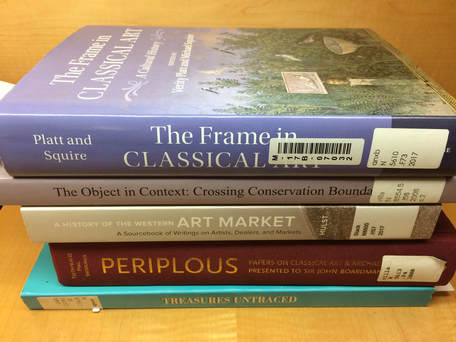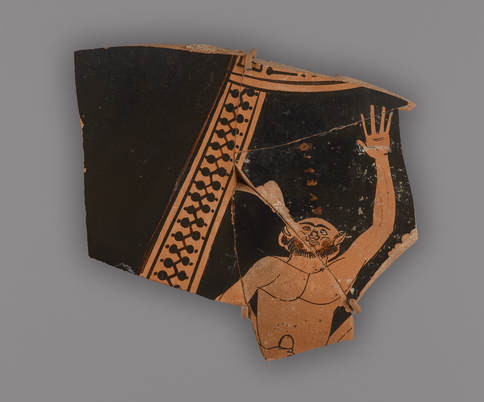1) Treasures Untraced: An Inventory of the Italian Art Treasures Lost During the Second World War (Ministero degli Affari Esteri, Rome, 1995)
I actually can't remember why I requested this book. I think perhaps because I've been reading Simon Goodman's The Orpheus Clock and have become really interested in the looting of art during the Nazi occupation in World War II. There's not just Classical art in this volume listing hundreds of objects stolen during the war, but art of all time periods. Since this is an inventory of objects still missing, it would be interesting to see if this list could be shorted now that it's been twenty years since its publication.
2) Periplous: Papers on Classical Art & Archaeology Presented to Sir John Boardman (ed. G.R. Tsetskhladze et al., Thames & Hudson 2000).
I've actually been long familiar with this volume of articles compiled in honor of John Boardman. On this occasion, I picked it up for a specific article, François Lissarrague's "A Sun-Struck Satyr in Malibu" (p. 190-97). I noticed this fabulous little fragment (85.AE.188) on display in the new Athenian vases gallery at the newly remodelled Getty Villa the other week. Lissarrague gave me some good chat on the inscription uttered by the masturbating satyr, which he translates to "I see two suns," and its possible meaning of "a dazzling light, a luminous phenomenon which, for the Greeks, marks an overwhelming abundance of life" (196). Isn't it a great fragment?
(JPGM 85.AE.188). Image courtesy of the Getty's Open Content Program.
Despite being far more conservation-heavy than myself, I picked up this collection of articles from a 2006 conference in Munich for an article by Getty colleagues Erik Risser and Jens Dahener, "A Pouring Satyr from Castel Gandolfo: History and Conservation (190-96)." I've been looking at this sculpture as it's the centerpiece of a new gallery at the Getty Villa devoted to Collecting and Provenance, and I wanted to see the history of its conservation in relation to its provenance. I was then delighted to see an interesting article Jens' and Erik's, "LACMA's Classical Sculpture Collection Reconsidered - Again" (by Batyah Shtrum), that goes into the Hope and Lansdowne collections at LACMA - more provenance, and connections to the Getty, that I will eagerly explore. So I might be keeping this one for awhile.
4) A History of the Western Art Market: A Sourcebook of Writings on Artists, Dealers, and Markets (ed. T. Hulst, University of California Press, 2017)
Fresh in from ILL, this volume shares snippets of many historical writings pertaining to the art market, from different times and geographical regions and a variety of perspectives amongst dealers, collectors, artists, and art historians. It looks like a rich resource, especially given its contemporary discussions. I will recommend it to collections development in the GRI; it should probably be a part of the Collecting & Provenance section of the library.
5) The Frame in Classical Art: A Cultural History (ed. V. Platt and M. Squire, Cambridge, 2017)
Someone recalled this from me, so I'll need to return it before I've looked through it as in-depth as I would like. Thirteen essays - each section has its own introduction, too - explore the theme of the frame, both in two- and three-dimensional art but also in the world of texts. Not surprisingly, many of these discussions of frames are metaphorical, discussing the narrative and visual choices of ancient artists in creating their areas of focus, as well as the afterlives of display and context. It's a rich volume, no doubt, and I look forward to exploring it more (when I recall it back, ha).


 RSS Feed
RSS Feed